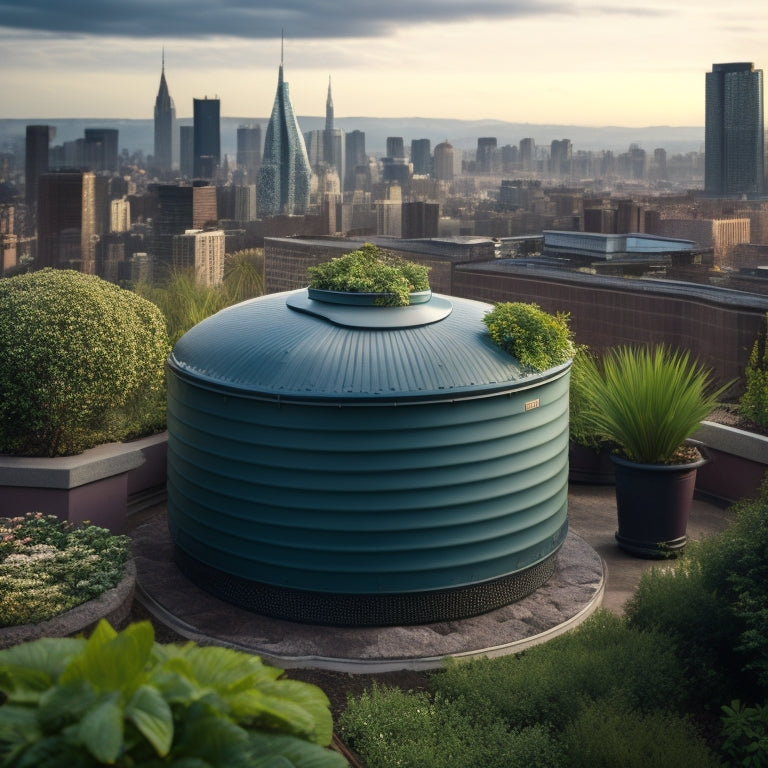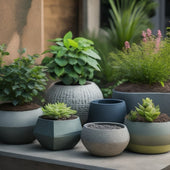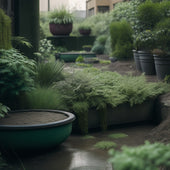
5 Ways to Collect Rainwater for Rooftop Gardens
Share
You can harness rainwater for your rooftop garden by installing a rooftop downspout diversion system, which redirects rainwater to your garden and reduces stormwater runoff. Consider gutter guard installation methods like drop-in or fastened guards to keep your gutters clog-free. Connect a rain barrel to your downspout using a diverter or adapter, and select a pump based on flow rate, pressure, and power requirements. You can also explore rooftop water storage solutions like polypropylene or stainless steel tanks, or opt for in-ground tank installation. By implementing these strategies, you'll be well on your way to maximizing rainwater utilization - and there's more to explore.
Key Takeaways
• Install a rooftop downspout diversion system to redirect rainwater to your garden, reducing stormwater runoff and irrigation needs.
• Connect downspouts to a storage tank, such as a rain barrel or in-ground tank, to collect rainwater for later use.
• Consider gutter guard installation methods, like drop-in or fastened guards, to keep gutters clog-free and ensure efficient water collection.
• Choose a suitable rooftop water storage solution, such as polypropylene or stainless steel tanks, based on water needs and garden size.
• Opt for efficient distribution methods, like solar pumps and drip irrigation, to maximize rainwater utilization and minimize losses.
Rooftop Downspout Diversion Systems
You can install a rooftop downspout diversion system to redirect rainwater from your rooftop to your garden, reducing stormwater runoff and harnessing a valuable resource for irrigation. This sustainable practice allows you to collect and utilize rainwater, reducing your reliance on municipal water supplies.
By redirecting rainwater from your downspouts, you'll reduce the amount of stormwater that enters the sewer system, minimizing the risk of combined sewer overflows and protecting local waterways.
Downspout redirection is a simple yet effective way to harvest rainwater for your rooftop garden. By connecting your downspouts to a storage tank or cistern, you can collect and store rainwater for later use. This approach not only reduces your water bill but also provides a free and sustainable source of water for your plants.
Rooftop garden benefits include increased crop yields, improved soil health, and reduced erosion. By embracing rainwater harvesting, you'll be adopting a sustainable practice that promotes environmental stewardship and independence from municipal water supplies.
Gutter Guard Installation Methods
As you prepare to collect rainwater for your rooftop garden, you'll need to ponder gutter guard installation methods. At least two primary gutter guard installation methods exist: drop-in and fastened, each with its unique benefits and installation requirements.
Drop-in gutter guards are easy to install and can be placed into existing gutters. They're a great option if you're looking for a quick DIY solution.
Fastened gutter guards, on the other hand, require more effort to install but provide a more secure fit. They're ideal for homeowners who want a more permanent solution.
When choosing a gutter guard, ponder a leaf filter that allows water to flow freely while keeping debris out. This will ensure your gutters stay clog-free and functional.
You may also want to ponder incorporating a rain chain, which can add a decorative touch to your rooftop garden while allowing rainwater to flow smoothly into your collection system.
Regardless of the method you choose, proper installation is key to ensuring your gutter guard system works efficiently and effectively.
Rain Barrel Connection Options
Connecting your rain barrel to the downspout is an essential step in collecting rainwater for your rooftop garden. You'll want to secure a connection to maximize water collection and prevent leaks.
One popular option is to use a downspout diverter, which redirects water from the downspout into the rain barrel. Another approach is to install a flexible downspout adapter, which links the downspout to the barrel. Make sure to choose a connection method that allows for overflow prevention, such as an overflow valve or a first flush device, to prevent waterlogging and erosion.
When selecting a pump for your rainwater collection system, consider the flow rate, pressure, and power requirements for your specific needs. You'll want a pump that can handle the water volume and pressure required for your rooftop garden's irrigation system.
Look for pumps with high efficiency and low energy consumption to minimize your environmental footprint. By choosing the right connection option and pump, you'll be well on your way to collecting and utilizing rainwater for your rooftop garden, enjoying the freedom to cultivate a lush and thriving oasis.
Rooftop Water Storage Solutions
With your rainwater collection system in place, incorporating a suitable rooftop water storage solution becomes essential for maximizing water harvesting and minimizing losses. You'll want to explore storage options that are durable, corrosion-resistant, and can withstand the elements.
One popular choice is a rooftop water tank, which can be made of materials like polypropylene or stainless steel. These tanks come in various sizes and can be installed above or below the rooftop surface.
When selecting a rooftop water storage solution, take into account your water needs and the size of your rooftop garden. You'll also want to think about how you'll distribute the collected water to your plants.
Solar pumps can be an efficient way to power your irrigation system, and drip irrigation is a great option for delivering water directly to the roots of your plants.
In-Ground Tank Installation
You'll need to excavate a pit for the in-ground tank, ensuring it's large enough to accommodate the tank's dimensions and allowing for easy installation and maintenance access. The pit's depth should be slightly deeper than the tank's height to enable easy installation and to prevent water from accumulating around the tank. Once the pit is ready, place the tank in it and backfill with soil, making sure to compact it properly to prevent settling.
Next, connect the tank to your rooftop rainwater harvesting system, ensuring a watertight connection. You'll also need to install an overflow valve to prevent water from accumulating in the tank and a first flush device to divert the initial flow of water, which may contain debris, from entering the tank.
With your in-ground tank installed, you'll be able to collect and store rainwater for your sustainable gardening needs. This rainwater harvesting system won't only reduce your water bills but also provide a reliable source of water for your rooftop garden, giving you the freedom to grow your own food and live more sustainably.
Frequently Asked Questions
Can I Use Rainwater for Hydroponic Systems in My Rooftop Garden?
You can definitely use rainwater in your hydroponic system, leveraging its benefits like increased crop yields and water efficiency. However, guarantee the rainwater's purity by filtering and testing it regularly to prevent contamination and maintain a healthy growing environment.
How Often Should I Clean My Rooftop Rainwater Collection System?
You'd need to clean your rooftop rainwater collection system a million times a day if you didn't maintain it regularly! Clean it every 1-3 months, depending on roof material and debris accumulation, to guarantee a smooth flow and prevent clogging.
Are There Any Local Regulations on Collecting Rainwater for Gardening?
You'll want to research local regulations on collecting rainwater, as they can vary substantially, imposing potential restrictions on your freedom to harvest and use rainwater for gardening, so be sure to check your area's specific rules.
Can I Connect Multiple Rain Barrels to Increase Water Storage Capacity?
You're like a master builder, constructing a water empire! You can connect multiple rain barrels to increase water storage capacity, amplifying benefits for your rooftop garden by creating a robust, decentralized system that harvests every precious drop.
Is Collected Rainwater Safe for Irrigation of Edible Plants?
When you use collected rainwater for irrigation, you're responsible for ensuring its quality; test for contaminants, pH, and nutrient levels to alleviate health concerns, as poor water quality can harm edible plants and your health.
Related Posts
-

5 Best DIY Planter Ideas to Upcycle Concrete
You're about to breathe new life into discarded concrete blocks by transforming them into functional and visually app...
-

5 Best DIY Planter Ideas to Upcycle Concrete
You're about to breathe new life into discarded concrete blocks by transforming them into functional and visually app...
-

5 Best DIY Planter Ideas to Upcycle Concrete
You're about to breathe new life into discarded concrete blocks by transforming them into functional and visually app...
-

5 Best DIY Planter Ideas to Upcycle Concrete
You're about to breathe new life into discarded concrete blocks by transforming them into functional and visually app...
-

5 Best DIY Planter Ideas to Upcycle Concrete
You're about to breathe new life into discarded concrete blocks by transforming them into functional and visually app...
-

5 Best DIY Planter Ideas to Upcycle Concrete
You're about to breathe new life into discarded concrete blocks by transforming them into functional and visually app...
-

5 Best DIY Planter Ideas to Upcycle Concrete
You're about to breathe new life into discarded concrete blocks by transforming them into functional and visually app...
-

5 Best DIY Planter Ideas to Upcycle Concrete
You're about to breathe new life into discarded concrete blocks by transforming them into functional and visually app...
-

5 Best DIY Planter Ideas to Upcycle Concrete
You're about to breathe new life into discarded concrete blocks by transforming them into functional and visually app...
-

5 Best DIY Planter Ideas to Upcycle Concrete
You're about to breathe new life into discarded concrete blocks by transforming them into functional and visually app...
-

5 Best DIY Planter Ideas to Upcycle Concrete
You're about to breathe new life into discarded concrete blocks by transforming them into functional and visually app...
-

5 Best DIY Planter Ideas to Upcycle Concrete
You're about to breathe new life into discarded concrete blocks by transforming them into functional and visually app...
-

5 Best DIY Planter Ideas to Upcycle Concrete
You're about to breathe new life into discarded concrete blocks by transforming them into functional and visually app...
-

5 Best DIY Planter Ideas to Upcycle Concrete
You're about to breathe new life into discarded concrete blocks by transforming them into functional and visually app...
-

5 Best DIY Planter Ideas to Upcycle Concrete
You're about to breathe new life into discarded concrete blocks by transforming them into functional and visually app...
-

5 Best DIY Planter Ideas to Upcycle Concrete
You're about to breathe new life into discarded concrete blocks by transforming them into functional and visually app...
-

5 Best DIY Planter Ideas to Upcycle Concrete
You're about to breathe new life into discarded concrete blocks by transforming them into functional and visually app...
-

5 Best DIY Planter Ideas to Upcycle Concrete
You're about to breathe new life into discarded concrete blocks by transforming them into functional and visually app...
-

Why Urban Gardens Need Better Planter Drainage Systems
When you neglect to install a well-designed drainage system in your urban garden, you're fundamentally sentencing you...
-

Why Urban Gardens Need Better Planter Drainage Systems
When you neglect to install a well-designed drainage system in your urban garden, you're fundamentally sentencing you...
-

Why Urban Gardens Need Better Planter Drainage Systems
When you neglect to install a well-designed drainage system in your urban garden, you're fundamentally sentencing you...
-

Why Urban Gardens Need Better Planter Drainage Systems
When you neglect to install a well-designed drainage system in your urban garden, you're fundamentally sentencing you...
-

Why Urban Gardens Need Better Planter Drainage Systems
When you neglect to install a well-designed drainage system in your urban garden, you're fundamentally sentencing you...
-

Why Urban Gardens Need Better Planter Drainage Systems
When you neglect to install a well-designed drainage system in your urban garden, you're fundamentally sentencing you...
-

Why Urban Gardens Need Better Planter Drainage Systems
When you neglect to install a well-designed drainage system in your urban garden, you're fundamentally sentencing you...
-

Why Urban Gardens Need Better Planter Drainage Systems
When you neglect to install a well-designed drainage system in your urban garden, you're fundamentally sentencing you...
-

Why Urban Gardens Need Better Planter Drainage Systems
When you neglect to install a well-designed drainage system in your urban garden, you're fundamentally sentencing you...
-

Why Urban Gardens Need Better Planter Drainage Systems
When you neglect to install a well-designed drainage system in your urban garden, you're fundamentally sentencing you...
-

Why Urban Gardens Need Better Planter Drainage Systems
When you neglect to install a well-designed drainage system in your urban garden, you're fundamentally sentencing you...
-

Why Urban Gardens Need Better Planter Drainage Systems
When you neglect to install a well-designed drainage system in your urban garden, you're fundamentally sentencing you...
-

Why Urban Gardens Need Better Planter Drainage Systems
When you neglect to install a well-designed drainage system in your urban garden, you're fundamentally sentencing you...
-

Why Urban Gardens Need Better Planter Drainage Systems
When you neglect to install a well-designed drainage system in your urban garden, you're fundamentally sentencing you...
-

Why Urban Gardens Need Better Planter Drainage Systems
When you neglect to install a well-designed drainage system in your urban garden, you're fundamentally sentencing you...
-

Why Urban Gardens Need Better Planter Drainage Systems
When you neglect to install a well-designed drainage system in your urban garden, you're fundamentally sentencing you...
-

Why Urban Gardens Need Better Planter Drainage Systems
When you neglect to install a well-designed drainage system in your urban garden, you're fundamentally sentencing you...
-

Why Urban Gardens Need Better Planter Drainage Systems
When you neglect to install a well-designed drainage system in your urban garden, you're fundamentally sentencing you...
-

Why Urban Gardens Need Better Planter Drainage Systems
When you neglect to install a well-designed drainage system in your urban garden, you're fundamentally sentencing you...
-

Why Urban Gardens Need Better Planter Drainage Systems
When you neglect to install a well-designed drainage system in your urban garden, you're fundamentally sentencing you...
-

Why Urban Gardens Need Better Planter Drainage Systems
When you neglect to install a well-designed drainage system in your urban garden, you're fundamentally sentencing you...
-

Why Urban Gardens Need Better Planter Drainage Systems
When you neglect to install a well-designed drainage system in your urban garden, you're fundamentally sentencing you...
-

Why Urban Gardens Need Better Planter Drainage Systems
When you neglect to install a well-designed drainage system in your urban garden, you're fundamentally sentencing you...
-

Why Urban Gardens Need Better Planter Drainage Systems
When you neglect to install a well-designed drainage system in your urban garden, you're fundamentally sentencing you...
-

Why Urban Gardens Need Better Planter Drainage Systems
When you neglect to install a well-designed drainage system in your urban garden, you're fundamentally sentencing you...
-

Why Urban Gardens Need Better Planter Drainage Systems
When you neglect to install a well-designed drainage system in your urban garden, you're fundamentally sentencing you...
-

Why Urban Gardens Need Better Planter Drainage Systems
When you neglect to install a well-designed drainage system in your urban garden, you're fundamentally sentencing you...
-

Why Urban Gardens Need Better Planter Drainage Systems
When you neglect to install a well-designed drainage system in your urban garden, you're fundamentally sentencing you...
-

10 Essential Tips to Prevent Disease in Vertical Gardens
You're about to discover the essential strategies to protect your vertical garden from disease, ensuring a thriving a...
-

10 Essential Tips to Prevent Disease in Vertical Gardens
You're about to discover the essential strategies to protect your vertical garden from disease, ensuring a thriving a...
-

10 Essential Tips to Prevent Disease in Vertical Gardens
You're about to discover the essential strategies to protect your vertical garden from disease, ensuring a thriving a...
-

10 Essential Tips to Prevent Disease in Vertical Gardens
You're about to discover the essential strategies to protect your vertical garden from disease, ensuring a thriving a...
-

10 Essential Tips to Prevent Disease in Vertical Gardens
You're about to discover the essential strategies to protect your vertical garden from disease, ensuring a thriving a...
-

10 Essential Tips to Prevent Disease in Vertical Gardens
You're about to discover the essential strategies to protect your vertical garden from disease, ensuring a thriving a...
-

10 Essential Tips to Prevent Disease in Vertical Gardens
You're about to discover the essential strategies to protect your vertical garden from disease, ensuring a thriving a...
-

10 Essential Tips to Prevent Disease in Vertical Gardens
You're about to discover the essential strategies to protect your vertical garden from disease, ensuring a thriving a...
-

10 Essential Tips to Prevent Disease in Vertical Gardens
You're about to discover the essential strategies to protect your vertical garden from disease, ensuring a thriving a...
-

10 Essential Tips to Prevent Disease in Vertical Gardens
You're about to discover the essential strategies to protect your vertical garden from disease, ensuring a thriving a...
-

10 Essential Tips to Prevent Disease in Vertical Gardens
You're about to discover the essential strategies to protect your vertical garden from disease, ensuring a thriving a...
-

10 Essential Tips to Prevent Disease in Vertical Gardens
You're about to discover the essential strategies to protect your vertical garden from disease, ensuring a thriving a...
-

10 Essential Tips to Prevent Disease in Vertical Gardens
You're about to discover the essential strategies to protect your vertical garden from disease, ensuring a thriving a...
-

10 Essential Tips to Prevent Disease in Vertical Gardens
You're about to discover the essential strategies to protect your vertical garden from disease, ensuring a thriving a...
-

10 Essential Tips to Prevent Disease in Vertical Gardens
You're about to discover the essential strategies to protect your vertical garden from disease, ensuring a thriving a...
-

10 Essential Tips to Prevent Disease in Vertical Gardens
You're about to discover the essential strategies to protect your vertical garden from disease, ensuring a thriving a...
-

10 Essential Tips to Prevent Disease in Vertical Gardens
You're about to discover the essential strategies to protect your vertical garden from disease, ensuring a thriving a...
-

10 Essential Tips to Prevent Disease in Vertical Gardens
You're about to discover the essential strategies to protect your vertical garden from disease, ensuring a thriving a...
-

10 Essential Tips to Prevent Disease in Vertical Gardens
You're about to discover the essential strategies to protect your vertical garden from disease, ensuring a thriving a...
-

10 Essential Tips to Prevent Disease in Vertical Gardens
You're about to discover the essential strategies to protect your vertical garden from disease, ensuring a thriving a...
-

10 Essential Tips to Prevent Disease in Vertical Gardens
You're about to discover the essential strategies to protect your vertical garden from disease, ensuring a thriving a...
-

10 Essential Tips to Prevent Disease in Vertical Gardens
You're about to discover the essential strategies to protect your vertical garden from disease, ensuring a thriving a...
-

10 Essential Tips to Prevent Disease in Vertical Gardens
You're about to discover the essential strategies to protect your vertical garden from disease, ensuring a thriving a...
-

10 Essential Tips to Prevent Disease in Vertical Gardens
You're about to discover the essential strategies to protect your vertical garden from disease, ensuring a thriving a...
-

10 Essential Tips to Prevent Disease in Vertical Gardens
You're about to discover the essential strategies to protect your vertical garden from disease, ensuring a thriving a...
-

10 Essential Tips to Prevent Disease in Vertical Gardens
You're about to discover the essential strategies to protect your vertical garden from disease, ensuring a thriving a...
-

10 Essential Tips to Prevent Disease in Vertical Gardens
You're about to discover the essential strategies to protect your vertical garden from disease, ensuring a thriving a...
-

10 Essential Tips to Prevent Disease in Vertical Gardens
You're about to discover the essential strategies to protect your vertical garden from disease, ensuring a thriving a...
-

10 Essential Tips to Prevent Disease in Vertical Gardens
You're about to discover the essential strategies to protect your vertical garden from disease, ensuring a thriving a...


